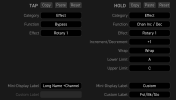Greg Ferguson
Legend!
I’ve had an original TC Stereo Chorus/Flanger for years, the one Eric Johnson used for his sound, but not for chorus or flanger. I kept the switch between them on the Vibrato setting and, running into a stereo amp setup, let the slow modulation pitch warble create chorus in the air on the way to the audience to mix in their ears. It’s more delicate.Some effects rely on the interplay between the wet signal and the dry signal. With those effects, 50% mix gives you the strongest effect. One example is chorus. 50% mix gives you the most chorus-like sound. At 100% mix, it devolves into a simple vibrato.
Last edited:

